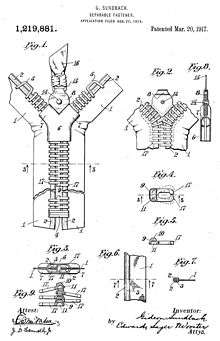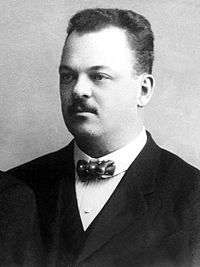Gideon Sundback
| Gideon Sundbäck | |
|---|---|
|
Gideon Sundbäck | |
| Born |
April 24, 1880 Ödestugu Parish, Jönköping County, Småland, Sweden |
| Died |
June 21, 1954 (aged 74) Meadville, Pennsylvania, United States |
| Resting place | Greendale Cemetery |
| Nationality | Swedish-American |
| Occupation | Businessman |
| Known for | invention of the zipper |
| Spouse(s) | Elvira Aronson, married in 1909; |
Gideon Sundbäck (April 24, 1880 – June 21, 1954) was a Swedish-American electrical engineer, who is most commonly associated with his work in the development of the zipper.[1]
Background
Otto Fredrik Gideon Sundbäck was born on Sonarp farm in Ödestugu Parish, in Jönköping County, Småland, Sweden. He was the son of Jonas Otto Magnusson Sundbäck, a prosperous farmer, and his wife Kristina Karolina Klasdotter. After his studies in Sweden, Sundbäck moved to Germany, where he studied at the polytechnic school in Bingen am Rhein. In 1903, Sundbäck took his engineer exam. In 1905, he emigrated to the United States.[2][3][4]
Career
In 1905, Gideon Sundbäck started to work at Westinghouse Electric and Manufacturing Company in Pittsburgh, Pennsylvania. In 1906, Sundbäck was hired to work for the Universal Fastener Company of Hoboken, New Jersey. Subsequently in 1909,[5] Sundbäck was promoted to the position of head designer at Universal Fastener.
Sundbäck made several advances in the development of the zipper between 1906 and 1914, while working for companies that later evolved into Talon, Inc. He built upon the previous work of other engineers such as Elias Howe, Max Wolff, and Whitcomb L. Judson. [6]
He was responsible for improving the "Judson C-curity Fastener". At that time the company's product was still based on hooks and eyes. Sundbäck developed an improved version of the C-curity, called the "Plako", but it too had a strong tendency to pull apart, and was not any more successful than the previous versions. Sundbäck finally solved the pulling-apart problem in 1913, with his invention of the first version not based on the hook-and-eye principle, the "Hookless Fastener No. 1". He increased the number of fastening elements from four per inch to ten or eleven. His invention had two facing rows of teeth that pulled into a single piece by the slider, and increased the opening for the teeth guided by the slider.[7]
The patent for the "Separable Fastener" was issued in 1917. Gideon Sundbäck also created the manufacturing machine for the new device. The "S-L" or "scrapless" machine took a special Y-shaped wire and cut scoops from it, then punched the scoop dimple and nib, and clamped each scoop on a cloth tape to produce a continuous zipper chain. Within the first year of operation, Sundbäck's machinery was producing a few hundred feet (around 100 meters) of fastener per day.

In 1914, Sundbäck developed a version based on interlocking teeth, the "Hookless No. 2", which was the modern metal zipper in all its essentials. In this fastener each tooth is punched to have a dimple on its bottom and a nib or conical projection on its top. The nib atop one tooth engages in the matching dimple in the bottom of the tooth that follows it on the other side as the two strips of teeth are brought together through the two Y channels of the slider. The teeth are crimped tightly to a strong fabric cord that is the selvage edge of the cloth tape that attaches the zipper to the garment, with the teeth on one side offset by half a tooth's height from those on the other side's tape. They are held so tightly to the cord and tape that once meshed there is not enough play to let them pull apart. A tooth cannot rise up off the nib below it enough to break free, and its nib on top cannot drop out of the dimple in the tooth above it. U.S. Patent 1,219,881 for the "Separable Fastener" was issued in 1917.[8]
The name zipper was created in 1923 by B.F. Goodrich, who used the device on their new boots. Initially, boots and tobacco pouches were the primary use for zippers; it took another twenty years before they caught on in the fashion industry. About the time of World War II the zipper achieved wide acceptance for the flies of trousers and the plackets of skirts and dresses.[9]
Sundbäck also created the manufacturing machine for the new zipper. Lightning Fastener Company, one early manufacturer of the zipper, was based in St. Catharines, Ontario. Although Sundbäck frequently visited the Canadian factory as president of the company, he resided in Meadville, Pennsylvania and remained an American citizen. Sundbäck was awarded the Gold Medal of the Royal Swedish Academy of Engineering Sciences in 1951. Sundbäck died of a heart condition in 1954 and was interred at Greendale Cemetery in Meadville, Pennsylvania.
Personal
On June 5, 1909, Sundbäck married Elvira Aronson, daughter of the Swedish born plant manager Peter Aronsson, in Hoboken, New Jersey.[10]
Legacy
In 2006, Sundbäck was honored by inclusion in the National Inventors Hall of Fame for his work on the development of the zipper.[9][11] On April 24, 2012, the 132nd anniversary of Sundbäck's birth, Google changed the Google logo on its homepage to a Google Doodle of the zipper, which when opened revealed the results of a search for Gideon Sundback.[12]
1917 patent
Sundback's U.S. Patent 1,219,881 (filed in 1914, issued in 1917):
References
- ↑ Gideon Sundbäck (National Inventors Hall of Fame)
- ↑ Inventing the 20th century: 100 inventions that shaped the world: from the airplane to the zipper. NYU Press.
- ↑ Petroski, Henry The Evolution of Useful Things (Random House of Canada, 1994) ISBN 0-679-74039-2 page 103
- ↑ Biographical Dictionary of the History of Technology. Taylor & Francis. p. 1181.
- ↑ DeMara, Bruce (April 24, 2012). "Gideon Sundback, inventor of the zipper, honoured by today's Google Doodle". The Star. Toronto.
- ↑ "The History of the Zipper". Thomas Publishing Company. Retrieved September 1, 2016.
- ↑ "''History of the Zipper'' (Thomas Publishing Company)". Thomasnet.com. Retrieved 2012-04-23.
- ↑ "''Gideon Sundback'' (Inventors & Inventions)". Design-technology.info. 2008-07-26. Retrieved 2012-04-23.
- 1 2 Zipper: An exploration in novelty (Robert Friedel, author. W. W. Norton and Company, New York, 1996) ISBN 0-393-31365-4
- ↑ Zipper: An Exploration in Novelty. W. W. Norton & Company. p. 74.
- ↑ Lightning Fastener Company Limited (Brock University)
- ↑ "Gideon Sundback celebrated in a Google doodle". The Guardian. London. 24 April 2012. Retrieved 24 April 2012.
Other sources
- Petroski, Henry (1992) The Evolution of Useful Things (Vintage Books) ISBN 0-679-74039-2
- Friedel, Robert (1996) Zipper: An Exploration in Novelty (W. W. Norton and Company) ISBN 0-393-31365-4
External links
| Wikimedia Commons has media related to Gideon Sundback. |




